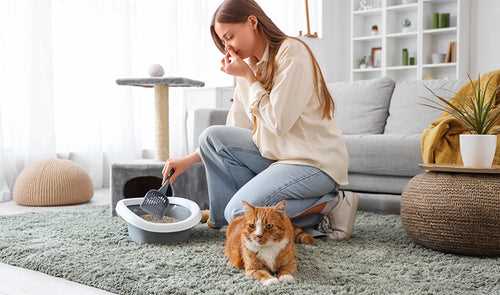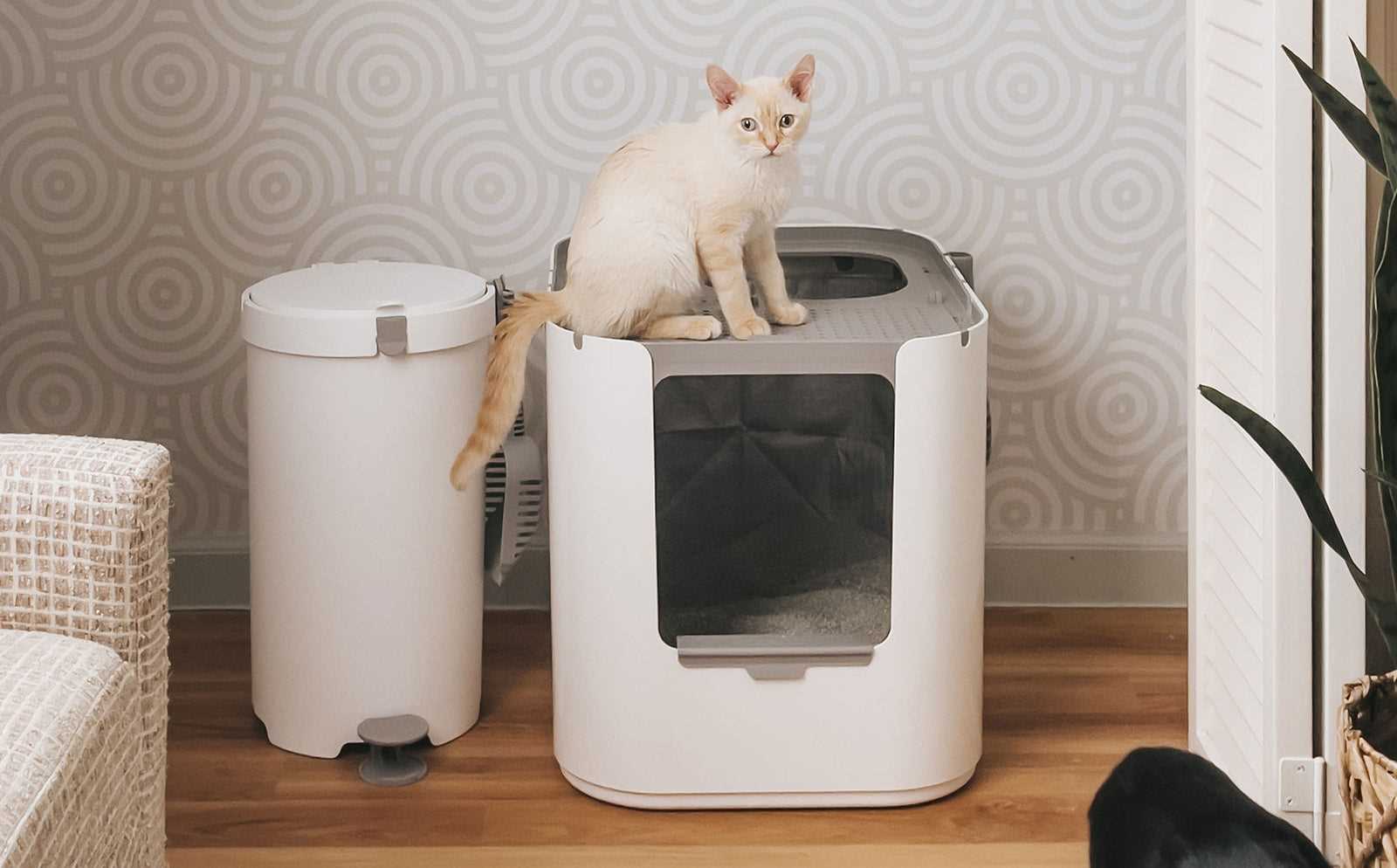



Regularly clean the litter box, scooping daily and changing the litter weekly. A clean environment makes a significant difference in odor control.
Invest in high-quality, odor-absorbing litter. Clay-based or natural options can help neutralize unpleasant scents effectively.
Designate specific areas for feeding and playing. This helps to contain any potential odors to a limited space, making it easier to manage cleaning routines.
Use enzymatic cleaners for accidents outside the litter box. These products break down organic matter, eliminating lingering scents that traditional cleaners might leave behind.
Introduce air purifiers equipped with HEPA filters to capture particles and odors, ensuring your space remains fresh and inviting.
Regularly wash bedding, blankets, and any fabric items your feline friend frequents. This practice helps to minimize buildup and maintain a pleasant aroma.
Consider the use of baking soda as a natural deodorizer. Sprinkling it in litter boxes or on carpets can absorb unwanted scents effectively.
Keep your space well-ventilated to allow fresh air to circulate, which can significantly reduce any lingering aromas.
Groom your companion frequently to minimize loose fur and dander, which can contribute to an unappealing atmosphere.
Eliminate Unwanted Odors

Regular cleaning of the litter box is a must. Scoop daily and replace the litter completely at least once a week. Consider using clumping litter for easier management.
Invest in an air purifier designed for pet owners. These devices filter out particles and odors, ensuring fresher air throughout your living space.
Utilize Natural Deodorizers
Place bowls of baking soda in various rooms. This natural substance absorbs unpleasant odors effectively. You can also try activated charcoal bags for additional odor control.
Essential oils, such as lavender or eucalyptus, can freshen up the environment. Just be cautious; some oils can be harmful to pets, so always check their safety first.
Choosing the Right Litter
Opt for clumping varieties. They form solid masses upon contact with moisture, making cleanup straightforward and keeping the area fresher. Look for options that contain natural ingredients like corn or wheat, which are often less pungent than traditional clay litters.
Odor Control Features
Seek litters infused with baking soda or activated charcoal. These substances are known for their ability to neutralize unwanted scents effectively. Some products also have added fragrances, but be cautious; strong scents can sometimes be off-putting for sensitive noses.
Regular Maintenance
Even with the best litter, consistency in cleaning is key. Scoop daily and change the entire box weekly. This routine prevents buildup and keeps everything pleasant. If you’re curious about water care, check out this guide on how to lower calcium in reef tank.
Establishing a Regular Cleaning Routine
I recommend setting a specific schedule for cleaning my favorite spots and litter area. Daily maintenance can keep odors at bay and ensure everything stays fresh. A simple plan might look like this:
| Day | Task |
|---|---|
| Monday | Change litter and clean the box with mild soap. |
| Tuesday | Wipe down surfaces where I like to lounge. |
| Wednesday | Vacuum the carpets and rugs in my territory. |
| Thursday | Wash my bedding and any fabric toys. |
| Friday | Deep clean the litter area and surrounding floor. |
| Saturday | Refresh air with a pet-friendly spray or diffuser. |
| Sunday | Inspect my grooming tools and clean them if needed. |
Consistency is key! By following this routine, any lingering scents can be managed effectively. Additionally, I suggest keeping cleaning supplies handy, so it’s easy to tackle any mess immediately. A clean environment makes my space more enjoyable for both me and my humans.
Implementing Air Freshening Solutions
For a fresher atmosphere, I suggest placing activated charcoal in various spots around the living area. This natural odor absorber works wonders in trapping unpleasant scents without adding any artificial fragrances.
Consider using essential oil diffusers with pet-safe oils like lavender or chamomile. Not only do these scents create a calming environment, but they also help mask any lingering odors. Always check for any adverse reactions from your furry friends.
Another option is to invest in air purifiers equipped with HEPA filters. These devices effectively remove particles from the air, including dander, hair, and odors. Place one in the most frequented areas for maximum effect.
For a quick fix, homemade spray solutions using water and a few drops of vinegar can neutralize odors. Just mix them in a spray bottle and lightly mist the areas that need freshening.
Lastly, consider incense sticks or candles made from natural ingredients. Choose scents that are soothing and not overpowering. Always supervise any burning items to ensure safety for all inhabitants.
Managing Your Diet and Health
Focus on high-quality nutrition to maintain freshness in your living space. A balanced diet rich in protein and low in fillers can significantly impact odor levels. Ensure I get premium wet and dry food, as hydration helps minimize waste smell. You might want to check out the best hydration for cats for tips on keeping me well-hydrated.
Regular Veterinary Checkups
Routine vet visits are crucial for monitoring my health. Conditions like dental disease or urinary tract issues can lead to increased odors. Keeping vaccinations and checkups up to date helps catch any problems early, ensuring I stay healthy and odor-free.
Weight Management
Maintaining a healthy weight is vital. Overweight felines may have more difficulty grooming themselves, leading to unpleasant scents. Regular playtime and appropriate portion sizes contribute to my well-being and help keep my fur clean and fresh.
Using Enzymatic Cleaners for Stains
Enzymatic cleaners are a game-changer for addressing stains and odors. These products contain enzymes that break down organic matter, effectively eliminating the source of unpleasant scents.
Here’s how to use them:
- Identify the stained area. Look for spots that might not be visible but still emit odors.
- Apply the enzymatic cleaner directly to the stain. Follow the instructions on the label for the best results.
- Allow the cleaner to sit for the recommended time. This gives the enzymes a chance to work on the stain.
- Blot the area with a clean cloth to lift away the residue. Avoid rubbing, as this can spread the stain.
- Rinse the area with water if necessary. Some cleaners may require this step to fully remove any leftover product.
Regular use of these cleaners on high-traffic areas can help maintain a fresh environment. It’s wise to keep a bottle handy for quick touch-ups, especially after any accidents or spills.
Always test a small, inconspicuous area first to ensure that the cleaner won’t damage your surfaces. With proper application, enzymatic cleaners can effectively tackle both stains and lingering odors.
Providing Adequate Ventilation in Living Spaces

Open windows regularly to allow fresh air to circulate. I enjoy the breeze that comes through; it helps clear out stale odors. If it’s too chilly outside, consider using exhaust fans in kitchens and bathrooms to remove moisture and airborne particles.
Invest in air purifiers equipped with HEPA filters. They capture tiny particles and can significantly improve air quality. I recommend placing them in common areas where I lounge the most.
Ceiling fans and portable fans can aid in distributing air evenly throughout the rooms. I love feeling the gentle airflow while lounging in my favorite sunny spot. Adjusting the fan direction can help push stale air out and bring fresh air in.
Check for any blockages in vents and ducts. Keeping them clean ensures that airflow remains unobstructed. A professional cleaning once a year can make a noticeable difference.
Lastly, consider creating cross-ventilation by opening windows on opposite sides of the space. This setup encourages a natural flow of air, making my environment much more pleasant.








